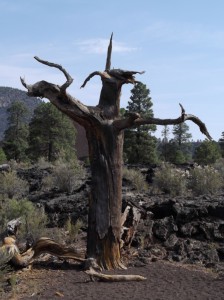After weeks of subfreezing weather, the temperature finally climbed into the mid-30’s and the sun was shining. Knowing more bad weather was on the way, I jumped at the chance to get out for a bit of air and headed down the trail to our neighborhood pond, which had partially frozen over weeks ago.
I stood for a few minutes and watched the ducks and geese as they came down the bank and skittered onto the ice, doing hilarious web-footed slide maneuvers across the ice until finally plunging into the bit of water that had not frozen over. Smiling at their antics, I continued on my walk.
It wasn’t until I rounded the last turn on the trail around the pond that I saw her–a tall woman with short, white hair, and like me, bundled up against the blustery January wind. She was looking up at the stand of trees at the end of the pond and when she saw me, she held up a hand in greeting. As I arrived at the spot where she stood, she lowered her gaze and looked at me with bright eyes. Her hand reached up to wipe away a tear.
“I forget how beautiful they are,” she said, and then apologized for being so emotional. I murmured that no apology was needed and looked up at the trees swaying below the vast canvas of the bright blue sky. Just trees, lovely in spring and fall, but in their bare, winter state, they seemed rather ordinary to me.
There are many trees that are spectacular beauties even without their leaves, trees that have a particularly attractive shape, or trees that have interesting patterns in their bark. So often we don’t see that beauty until the trees lose their leaves in the fall, leaving branches and trunks exposed. But these trees seemed to me to just be trees, their winter selves unspectacular until spring once again adorned them with their leafy finery.
I stood with her for a few minutes looking up at the bare branches. She took a deep breath and nodded a farewell to them and to me. Her last words stunned me, “At least I’ll have one more year with them.” And then she turned and continued down the trail.
As I watched her walk away I pondered the meaning of her startling words. She had seemed quite healthy, but perhaps she was sick. Or maybe just getting ready to move to another neighborhood. I looked back at the trees again, still just trees, but somehow now majestic and a talisman to remind us to let even that which is ordinary take our breath away.
Walking home, I thought about other trees I have encountered in my wanderings, the ones that I have called Spirit Trees, that somehow manage to stay proudly upright, long after they are supposedly “dead”.
Later that evening, I curled up in front of the fire with Sue Monk Kidd’s novel, The Invention of Wings, in which one of the main characters, Handful, and her mother Charlotte continue a tradition of keeping their spirits in a tree. Fascinated, I stayed up reading, finishing as the morning light began to tiptoe around the edges of the blinds.
There is much that has been written about the spirit of trees, Mary Oliver, Hermann Hesse, Wendell Berry, to name a few of the more famous scribes who have visited this place in their own worlds. (For more wonderful writing about trees, click here, and for a fascinating compendium of writing about the spirit of trees, consider visiting this site).
Clearly, for the woman that I met at the pond, the little stand of trees holds deep spiritual meaning and I hope that she has many more opportunities to visit with them. But even when the day comes that she can no longer walk down that particular trail, they will always be with her.



